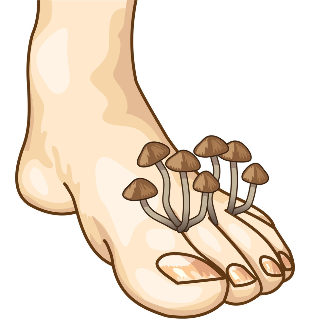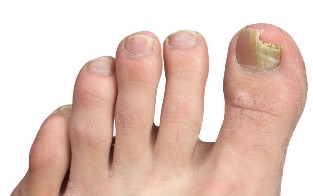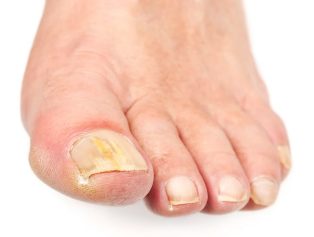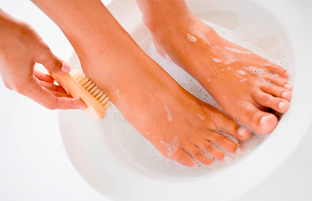Fungal infection is very often a toe or finger nails. This disease affects adults and children. To avoid the pathology of the transition in the chronic Form, it is necessary to know the signs of mildew on the legs and how does such a disease.

The most important signs of the disease
Among all the diseases of the skin athlete's foot is the most common. By viruses, such as illness, ignores the elementary rules of Hygiene. Heal same fungus is sometimes very difficult.
Every person mushroom of the legs begins and develops in its own way. Here are the most common reasons why you can recognize athlete's foot are:
- between the toes, the characteristic cracks appear;
- to understand that the fungus appeared, may be due to the characteristic itching of the feet and between the toes;
- the skin is very dry, often flaky and rough;
- between the fingers of the bubbles, the bursting in of the destruction will be;
- the infection can the transition to the neighboring land;
- on the skin, reddish patches that cause significant complaints arise;
- learn the fungus to the legs and can be unpleasant odor.
Signs of mildew depending on the type of pathogen
This disease develops due to different types of pathogens. Symptoms of the legs are different in each case.
- If the legs of a yeast fungus develops, then gradually thin nail, peels himself from the bed. The skin on the sole of the foot hyperemic (gets red shade).
- In the development of a fungus, the nail yellowed, with stains. The skin of the feet and flakes of a unpleasant smell is coming from. Characteristic Symptom of this type of mushroom increased dryness of the skin.
- Upon the occurrence of mold nail plate can drastically change your color. The skin is red, if the causative pathology is gradually on the whole sole of the foot. People are worried about itching, the skin can crack. In this case, pain while walking, and other unpleasant sensations.
You determine the type of pathogen, only a doctor can. At home it is not possible. And if self-treatment practice, you can hurt yourself. The feet suffer, the skin and the fungus will always spread more and more.
Signs for certain forms of the fungus
Depending on the affected area and the extent of the development of various forms of pathology are different. To distinguish the symptoms of each of them. Early signs of disorders of the feet, know you can start early with the treatment of fungal infection.
- Mejpaltsevaya skin fungus is confirmed — the most common stages of the disease. It is activated in the spring and in the summer, when the feet sweat the most. Between the fingers, the cracks and sores appear. You notice the presence of dandruff on your skin. The foot looks perfectly healthy. Often the person feels the itching.
- Sub-clinical Form is manifested in the least pronounced degree. Between the fingers clear Peeling. In this stage of the disease a strong unpleasant smell spreads from the feet: he appears to be due to the increased activity of the bacteria.
The disease is capable of leaking in various forms. You read the signs, to know how to identify fungus on the feet and to begin, in the case of its development the treatment. You have to remember that on the started stages of the nail is completely destroyed. Repair is almost impossible.

Flake-Type
For such a mushroom characteristic of the intense exfoliation of the Epidermis. The most affected areas of the skin between the fingers and the side of the foot. Characters of the same inflammatory process are missing. On the photo the first signs of powdery mildew legs areas of hyperemia. Flaky mushroom looks like this:
- the Horny layer is thickened;
- the skin is shiny, sometimes thick;
- the drawing on the skin becomes clearer;
- the fungus gradually spreads to the fingers, the whole sole of the foot, affects the nails;
- sometimes on the Epidermis Banded scales appear;
- other symptoms the Patient feels.
Chronic Type
In the case of this fungus on the skin appear small blisters, filled with fluid. Usually they are in the lateral part of the foot. Then you have to gradually move to the inner side of the Finger How to recognize the fungus on the legs chronic type:
- the bladder as a rule individually, but if many are, then they will merge into a large;
- if left untreated, fluid in the blister gradually darker;
- when the bubble bursts, then in its place appears with a crust Erosion.
Intertriginous Type
This type of fungus is the most common. First of all, the Person will not feel any symptoms. Up to a certain point, the skin on the toes is not changed. In the future, there are cracks, layering. The skin is not affected, but it can be sweating.
Defeat mushroom stop
The characteristic symptoms of this fungal infection of the following:
- the lesion is a 3 — th or 4-th Finger of the foot;
- the skin is red and swollen;
- to the lesion, a bladder, where it is separated layer of the skin;
- in the vicinity pustules, blisters are.
Signs of fungal infection of the nails
When people may be affected and nails of the feet. To distinguish the disease in the symptoms.
- A pronounced change in the color of the plate of the nail. Depending on what type of pathologies in patients, nail the variety of shades acquire. Sometimes he can plate on only part of the nail.
- Crumbling of the nail. It only comes on the started stages. If the nail is completely infected, it is destroyed.
- The change in the structure of the nail.
There are several varieties of onychomycosis — fungal infection of the nails.
- Atrophic Appearance. The plate of the nail looks very thin. It darkens, sometimes grayish-brown in color. Nail gradually strips out of his Lodge. The skin under him, rough and loose.
- In normotroficheskie the Form of fungus foot-plate changes its hue. On your spots appear white, yellow, green and even black. The structure of the nail does not suffer.
- In the case of hypertrophic Form of the plate gradually thickens, becomes porous. The affected area looks very ugly and in some cases, the cause of the pain is when walking. On the sides it is crumbled and without treatment destroyed.

Some varieties of onychomycosis
Depending on the degree of spread of the disease, such shapes can.
- The lateral onychomycosis is the most common. On the free edge of the nail with a small yellow spot appears first. In the future, you may need to be thickened to notice, as it rises, the nail and the plate. While walking, the man discomfort feels. Clearly the spread of the unpleasant odor. The lateral onychomycosis is difficult to treat.
- Superficial onychomycosis defeat is typically only the upper layers of the plate. It is not thickened, but with time is similar to the chalk.
- The rare Form of the disease is subungual onychomycosis. The skin thickens noticeably in the nail-fold. The nail becomes white and loses its transparency.
Risk group
Actually, "catch" fungal risk, wherever you want — even at home. But in public, of course, a lot more opportunities (if you're not careful).
Who is at risk?
More than just a lift, tires mushroom people with the following diseases risk:
- Flat feet and foot deformities.
- Disturbed Blood Circulation.
- Excessive sweating of the feet. Often mushroom "brackets" athletes and military, due to the peculiarities of the walk in tight or uncomfortable shoes in the heat.
- The presence of corns on the feet, but also people with rough and thick skin on the feet.
- Low Immunity.
- The presence of chronic diseases.
- Frequent injuries of the skin around the nails yourself nail plate. To belong to this category lovers pedicure in the Salons, or the people, disregard of rules of Hygiene.
- Diabetes mellitus.
General principles of treatment
Each treatment of the pathology starts with the diagnosis. Only then the suitable medium may be assigned. Self-treatment usually leads to a deterioration of the legs. Read the most widespread methods of therapy.
- At the first signs of fungus infestation of the special paints, plasters, ointments, Sprays. You will need a long time and apply according to the instructions.
- With the ineffectiveness of local therapy, anti-prescribe antifungal medication complex action. They are administered orally.
- The surgical removal of the affected nail.
- The Laser Therapy.
- In the case of the advanced Form of the disease, the medication can be administered.
Prevent the formation of unpleasant diseases possible, respecting the rules of Hygiene. Avoid the use of foreign facilities for personal Hygiene (towel, Slippers). At the first signs of the disease should immediately consult a doctor.
10 best home remedies of nail fungus

If you suspect nail fungus, at the same time as treatment with a specialist, you can apply one of the methods. It is not recommended to get him instead of the treatment at the doctor— you risk exacerbating the Problem, and then the healing process is really long and frustrating.
So, what are the means of reaching us from our grandmothers and great-grandmothers?
- Regular treatment of nails with one of the following: Propolis tincture, antiseptic tea tree oil, Apple cider vinegar.
- Foot bath.For you sea salt (and preferably without additives) can, extract of celandine, yarrow, St. John's wort, oak bark, chamomile, calendula etc. To the bathroom should the nails to smear lemon juice, iodine or Apple cider vinegar.
- Iod. The essence of the treatment: apply twice a day, damaged nails (for 20 days) and 1-2 drops of iodine. If treatment is successful the then to the processing of 1 times in 3 days.
- Kombucha. Its Infusion is as a compress. Enough to soak gauze, apply the gauze and leave over night under a polyethylene and socks. You can also directly apply Kombucha to the nails, and then you need to connect and leave it for a couple of hours. According to steam the legs, and apply the mixture of Apple cider vinegar (1 part), alcohol 96% (2 parts), Glycerin (2 parts). Leave overnight. The course of treatment is 2 weeks.
- Garlic oil.Fill out the garlic in the hot sunflower oil, rubbed up to the complete covering of the garlic. All mix, close tightly and insist 2 days. The essence of the treatment: swab moistened in oil, apply to the painful area, we place a bandage from the top of polyethylene to protect wear socks and leave for the night. Course — 2 Weeks.
- Vinegar.Cotton swab moistened in vinegar (9%), apply on the affected parcel, polyethylene wrap, fix the patch and leave for the night. In the morning repeat everything.
- Soda with greater celandine. Float your feet in the solution (3 L of water + 1 tbsp/L of Soda), wipe of the foot, lubricates patient areas, together with the Butter with your fingers celandine (look in the pharmacy). Course — 2 Weeks.
- Birch tar. Feet to float with the use of hoz/Soaps (about 20 minutes), clean the feet with a pumice stone, trim nails, dry wipe the feet and the nails lubricates birch with the fingers-tar. You put the feet on the newspaper to 1.5 hours and read a book. Next, we remove create excess tar Association, put on x/B socks and forget, when the legs for a few days. After the expiry of my feet again with hoz/soap and cold water. In the evening, repeat the process. Course — 2 Weeks.
- Kalanchoe. Treatment: on unpainted nails glue with plaster of leaves of Kalanchoe so you can cover together with holes for the nails. Pavement with leaves change from day to day. Course — 2-3 Weeks.
Prevention Of Nail Fungus
To protect yourself from mildew, you can very simply comply with the rules of Hygiene and preventative measures in good time.
Remember:

- In all public areas (beaches, shower, locker room, Pool, Spa-Salons, etc.) to wear easily washable Slippers. Do not go barefoot where there is an infection risk!
- Not on strangers shoes (including Slippers to guest, it is better to go in the socks).
- Use files no strangers to towels and nail.
- Get out of the bathroom, put the legs in General (and often wet, not the first freshness) Mat, but on the same towel his (mark it in advance such purposes).
- Regularly check the feet and nails for the appearance of signs of powdery mildew see. At the slightest signs (cracks appeared/itching between the fingers, changed to take the color of the nail, etc.) measures. That is, ointments acquire, special paints, etc.
- Try not to use a tight, narrow shoes and shoes made of inferior materials.
- Regularly treat your shoes from the inside antiseptics.
- Thus, the feet do not sweat, use Deodorants, talc, etc.
- Only x/B socks. To remove the use of the tights/stocking (products made of Nylon and other synthetic fabrics) at home make sure you float the legs, treat.
- In the heat wear open shoes — for ventilation and free air exchange. Sweaty feet — ground for bacteria.
- Not our shoes fairs in the shops without socks/footsteps— barefoot.
- Dry wipe the feet after bathing, including the spaces between the fingers — exactly from there the fungus begins to.
- Tolerate no cracks on the feet, use moisturizers.
- The legs of my mild anti-bacterial soap.
- In the case of a high risk of infection (for example, on holiday or in the pool) use the antifungal cream, powder or spray.
- Thoroughly dry the shoes, if they are wet. Not to wet shoes/boots.
- Choose only certified Salons for a pedicure/manicure.
- Not ingrown and deformation of the nails allow you to — take action on time.































